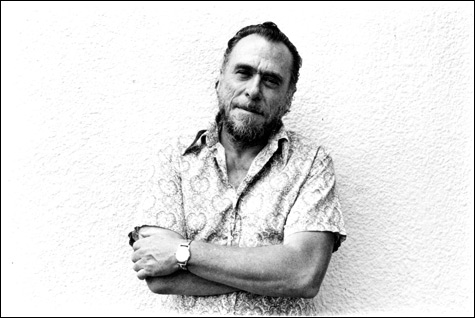
All images copyright Gerard Malanga. |
In Walt Whitman’s notebook for the 1855 edition of Leaves of Grass, he writes, “Every soul has its own individual voice.” That notion rang true for photographer/poet/filmmaker Gerard Malanga as he put together “Souls,” an exhibit of 100 portraits spanning five decades.
Malanga may be best known for his work with Andy Warhol, with whom he founded Interview magazine and collaborated on many films. He has authored several books of poetry, as well as the band-bio Up-tight: The Velvet Underground Story, and maintains an archive of photographs and movies from his years at Warhol’s Factory.
“Each person [was] staring at me through the soul of their eyes, looking at me with their whole being, as it were,” explains Malanga of his new exhibit. “So this exhibit would be a first gathering of souls. I had always wanted to exhibit my portraits in such a way not to differentiate between those easily recognizable faces or names that come with a public history of sorts, past or present, and those persons whose everyday lives are not marked by fame but by a quiet, unassuming achievement.”
We reached him recently by e-mail to talk about the show.
How did you go about putting this collection of portraits together? Is there a common thread among the people you've chosen for the show?
This exhibit, “Souls,” at Pierre Menard Gallery in Cambridge came about slowly and was carefully thought out several years back. I had always wanted to exhibit my portraits in such a way not to differentiate between those easily recognizable faces or names that come with a public history of sorts, past or present, and those persons whose everyday lives are not marked by fame but by a quiet, unassuming achievement. People who possess the knowledge to be good at what they do. Friends and acquaintances and sometimes strangers, too, who have meant much to me through the years. Friendships even ensued from the casual portrait.
There was literally a thousand or so portraits to choose from, but I set for myself a fairly focused criteria. The first priority was to fix a number for the show and aim at that. One hundred sounded just right. I could then keep an eye on the quality of the composition or some element of texture and light surrounding the person that felt special, unique. The approach was intuitive, to say the least.
I was also looking for pictures that hadn’t been reproduced, thus retrieving from the past an image that might otherwise not have surfaced. And lastly, what that person’s connection was or has been for me. The nature of the friendship, or the memory of a friend long since gone. Any one of the above, or a combination of all three, was the goal.
Photographs have a way of saying “Hello” and “Goodbye,” and in between those two points in time exist the lives of those likenesses, then and now. Stepping into the photo all memory stops.
You’re based in New York state — how did you end up booking the show in Cambridge?
I’ve had a direct connection with this town since spring 1965, when I first stayed with my friend, Ed Hood, for a week at his ground-floor flat over on Mt. Auburn Street (known in the ’60s , I would later learn, as the “University Road murder building”). The apartment building still stands. Ed was the perennial PhD candidate at Harvard who never got his degree, but in my eyes he was the guru, par excellence.
I even lived here for a short spell in Fall of ’73; first on Boylston Street just off the Square, then on Putnam Avenue a half-block from the Orson Welles Cinema. But it’s now nearly four decades later and nearly everyone I knew has passed on or moved on. Ed Hood is gone and Rosie Blake, too. Barry Savenor. Jim Randall. Gordon Cairnie. Edie Sedgwick, Bruce Pecheur. Vivian Kurz and Gordon Baldwin and Charles Giuliano have pulled up stakes many years passing. The O’Neill brothers’ Temple Bar Bookshop, first near Porter Square and later just off Harvard Square, remains a dim and haunting memory.
You seem to have an interesting connection with each of your subjects. Would you share the stories behind some of your portraits?
Henri Cartier-Bresson, given his mood swings, remarked how you can’t print a memory, but you can photograph the past in real time and that’s what he’s done and that’s what I’ve done too, these past 40 years now. Out of a hundred, here are five that still remain fresh and vivid from when I first snapped them.